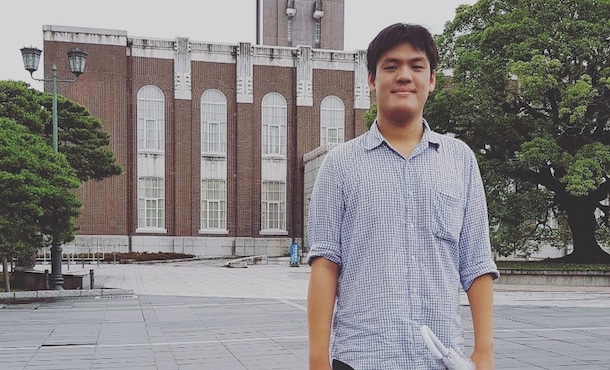
Atip Lawanprasert during his research internship at Kyoto University in Japan. Image provided by Atip Lawanprasert
Student's love of research brings him to Penn State
Biomedical engineering's focus on undergraduate research appeals to Thai student
6/11/2019
UNIVERSITY PARK, Pa. – Penn State’s biomedical engineering undergraduate program stresses practical research experience for its students. Which is why Penn State was a perfect fit for Atip Lawanprasert.
Lawanprasert is a 2018 Penn State biomedical engineering graduate and a current Penn State bioengineering graduate student, arriving at University Park from his native Thailand with a love of research that was sparked in high school. Lawanprasert immediately immersed himself in the lab, completing two international research internships and two Penn State summer research projects as an undergraduate.
Lawanprasert’s first internship was in summer 2015 at the National Nanotechnology Center (NANOTEC), part of the National Science and Technology Development Agency in Thailand. NANOTEC’s work focuses on testing the toxicity of various nanoparticles and how that toxicity affects humans. As a NANOTEC intern, he worked in the Nano Safety and Risk Assessment Laboratory, exploring the toxicity of silver nanoparticles.
Silver nanoparticles has multiple medical applications because of its ability to kill germs, but there are still ongoing concerns about possible toxic side effects on human body. Lawanprasert’s research specifically focused on the effects of silver nanoparticles on human white blood cells.
“My NANOTEC internship was my very first experience in laboratory practice,” Lawanprasert said. “Experiencing the experiment process first-hand inspired me to further my interest in research. Also, working with the professional researchers taught me a lot of valuable knowledge that I apply today.”
Lawanprasert’s second internship took place at the Kyoto University Graduate School of Medicine. While there, he researched an unusual phenomenon that occurs in a monkey’s brain during a spinal cord injury; some parts of the brain are activated to help mitigate any loss of muscle movement control following the injury.
Lawanprasert also studied machine learning for the first time, exploring the possibility of using machine learning to predict how long it would take for patients to recover from spinal cord damage.
“I was exposed to the vast possibilities of machine learning to predict the trends in the biomedical field,” Lawanprasert said.
His summer research sessions at Penn State included working with the late Erwin Vogler, former professor of materials science and engineering, in 2016. His focus while working with Vogler was on blood coagulation, the process by which blood turns from liquid to gel to form a blood clot, and how this happens on the biomaterial surfaces.
His second summer research experience was in 2017, working in the laboratory of Scott Medina, assistant professor of biomedical engineering. He explored the diagnostic and therapeutic potential of bio-sourced macromolecules, including potential for treatment of cancer.
Medina mentored Lawanprasert while he was an undergraduate student, and immediately found him to be a driven student and researcher.
“Atip has a true passion for discovery,” Medina said. “His love of science, complemented by his kind and helpful demeanor, makes it a real joy to mentor him.”
After Lawanprasert graduated in 2018 with a bachelor of science degree and honors in biomedical engineering, he became a bioengineering graduate student working in Medina’s lab. His graduate research focuses on the development of a new nano-size drug delivery system for gene therapy. By being able to control the gene expression in the targeted cells, researchers are able to guide the cell’s faith, including the cell death.
“Gene therapy has been proven to possess high potential for various biomedical applications,” Lawanprasert said. “However, the nucleotide materials, a crucial part of gene therapy, face many challenges, such as membrane permeability and in vivo stability, which prevents them from functioning at the highest efficacy. Luckily, our new drug delivery system may be able to overcome these challenges.”
This has a great potential for future cancer patients, as this new drug delivery system could enable specific targeting of cancer cells and greatly reduce off-target toxicity. Off-target toxicity refers to drugs effecting cells other than the target cells and is a major contributor to pharmaceutical adverse side effects.
“Our drug delivery system could greatly improve the well-being of the cancer patients as the side-effect will be significantly less than the current chemotherapy,” Lawanprasert said.
While he is currently involved in the different types of research, Lawanprasert said that his undergraduate research experiences have been vital to his practical education, and he believes it has made him a better graduate student.
“Working with researchers from many parts of the world and in multiple fields of study has broadened my viewpoint,” Lawanprasert said. “Especially in learning how to solve problems by considering a wide variety of ideas to form a fitting solution.”



